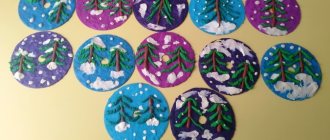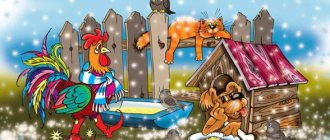Summary of a lesson on speech development in the middle group of kindergarten. Dramatization of the fairy tale “Turnip”
Summary of educational activities on speech development in the middle group through play - dramatization based on the fairy tale “Turnip”
Duration of educational activities:
20 min.
Goal: creating conditions for the development of children’s speech through the game-dramatization of the fairy tale “Turnip”. Objectives: educational:
expand the child’s general horizons about theatrical activities through fairy tales;
developing:
to develop speech activity, creativity, the ability to convey the image of a fairy-tale hero through gestures and facial expressions);
educational:
to cultivate friendly relations in the children's team.
Types of children's activities: gaming, communicative, motor, musical. Equipment: invitation to the fairy tale “Turnip”, chest with a map, house model, masks of fairy tale heroes, cut-out pictures of fairy tale heroes (animals), clearing (hoop) with turnips, rope walkway, letter. Technical support: Power Point software: slides with demonstration pictures, audio recording of “Fanfare”. Stages of activity Contents Problem solved at this stage Child's activity Adult's activity Proposed result Part 1. Org. moment Greeting Surprise moment. (Knock on the door. A storyteller in a folk costume enters.) I really love fairy tales, and you? Have you ever been to the theater? Do you want to visit the theater? Here's an invitation for you, I'll take you to the theater. (children go to the music room) Get most of the children interested. Switch children from gaming activities to educational ones. Completion of children's independent activities. Organizing children for educational activities. Get as many children interested as possible. The child's ability to make his own decisions. Part 2. Main Creation of a problem situation (Slide 1. Image of the theater) Sit down, now the fairy tale will begin. (The fanfare sounds and then stops) What happened? There won't be a show? (Presentation of the chest). Guys, look, what's here? What do you think is inside? Inside is a map with tasks: “Walk along the map, find all the heroes of the fairy tale and become the heroes of the fairy tale yourself.” Involve children in educational activities. The ability to listen to a problem and the ability of children to resolve the situation. Organization of children through the creation of a problem situation. Demonstration of children's desire to solve a problem situation. Motivation for activity Conversation. - Guys, what should we do? Do you want to go on a journey and meet heroes? Encourage children to have an open dialogue with the teacher. Children's reasoning on the proposed questions. Conversation using leading questions. Ability to conduct dialogue with adults and peers. Performing actions. Show a presentation based on the tasks in the map. (Slide 2). A game-conversation for the development of dialogical speech (rhymes about grandparents, children’s description of their qualities). (Slide 3). Game – sketch “Turnip” (movements with words). (Slide 4). A riddle about a granddaughter showing illustrations from fairy tales. Game “Where does the granddaughter live?” Work in subgroups. Puzzle game “Collect the picture” (animals from a fairy tale) Guide children to the goal in completing tasks. Develop creative imagination, fantasy, the ability to perform movements in accordance with the text, and expand vocabulary. Discussion conversation with adults. Perform movements according to the text. Guessing riddles, ability to work in subgroups. Explanations of slides, participation in dialogue and explanation of the work to be done. Construction of a speech utterance. Theatrical activity - Guys, what heroes did you meet along the way? What is the name of the fairy tale? Would you like to become an actor? Choose your role and we will show you a fairy tale. Children's dramatization of the fairy tale "Turnip". Invite the children to take on the role of any fairy tale hero and show the fairy tale. Show the children the fairy tale. Verbal instruction from the teacher. Showing children's interest in taking a certain role in joint play activities, based on the desires of the child himself. Part 3. Final Analysis of performance results, reflection - Which tasks were especially interesting?
-Did you like all the tasks? Was it difficult to play roles? Which role did you like best? Summing up the results of educational activities. Answer questions. Evaluate their work and the work of other children. Ask leading questions about the work done. Analysis of completed tasks by children. Download Notes on speech development in the middle group through play - dramatization of the fairy tale “Turnip”
We recommend watching:
Summary of a lesson on speech development in the middle group on the topic: “Ukraine is my native land” Notes on the development of speech in the middle group Notes on the lexical topic “Transport” for children 4-5 years old with severe speech impairments Notes on the development of speech in the middle group middle group
Similar articles:
Summary of a lesson on speech development in the middle group on the topic “Our Street”
Summary of a lesson on speech development in the middle group “Dramatization of the Russian folk tale “Turnip””
Municipal preschool educational institution “General developmental kindergarten No. 95”, Voronezh
Summary of a lesson on speech development in the middle group
“Dramatization of the Russian folk tale “Turnip”
Educator:
P.
Topic: “Dramatization of the Russian folk tale “Turnip”.
Goal: Remember the fairy tales you read with your children. Teach children to tell the fairy tale “Turnip” emotionally, with elements of dramatization, using a tabletop theater. Develop children's speech, thinking, memory, attention. Teach children to dramatize the fairy tale “Turnip”. Cultivate a love of fairy tales, the ability to listen to each other, and work together. Remember polite words.
Materials: illustrations for fairy tales, masks for the fairy tale “Turnip”, theater tickets, spatula, watering can.
Progress of the lesson:
The children sit in a semicircle on the carpet.
— Guys, do you like to travel? (Children's answers).
—Where can you go on a trip? (Children's answers - to the forest, to the river, to the park, to the sea, to another city).
“But today you and I will not go on an ordinary journey, but into a fairy tale.”
Fairy tales ask: And now you, friends, get to know us! (I show the children a large book of fairy tales.)
- Guys, fairy tales are asking us to recognize them. Want to? Then listen carefully.
- Didn't lie on the window
Rolled along the path...
I didn’t tremble before the wolf,
Ran away from the bear
And the fox's teeth
Still got caught... (Kolobok).
- Oh, Petya - simplicity,
I messed up a little
I didn't listen to the cat
Looked out the window... (The cockerel is a golden comb).
— Guys, in which Russian folk tale did the girl say:
- I sit high, I look far away,
Don't sit on a tree stump
Don't eat the pie
Bring it to grandma, bring it to grandpa. (Masha and the Bear).
- Round side, Yellow side,
Gingerbread man sits on the garden bed,
What is this... (Turnip). (Showing the turnip to the children).
- Look, guys, what a turnip. What is the color of a turnip?
(Children's answers - in the sun, chicken, orange, butter).
- What about the form? (on a ball, kolobok, sun, ball).
- What about the taste? (for honey, sugar, sweets).
- What else does a turnip have? (Children's answers: the tail is green).
- Who else has a tail? (cats, mice, dogs).
Well done, guys, would you like us to try to come up with a riddle about a turnip ourselves?
Round like a ball
Sweet like honey
Yellow like butter
With a tail, but not a mouse, (turnip).
- Guys, do you remember the fairy tale about the turnip? Do you want to tell it together?
with me? (The children take turns, together with the teacher, tell
fairy tale, while simultaneously exhibiting tabletop theater characters).
- Well done guys, you told the story well. And now you want
become artists? (Children's answers). Let's assign roles, dress
masks, choose a storyteller and show the fairy tale ourselves. (I dress the children
masks, they return to their places).
— The theater is opening! Everything is ready to start! Tickets are sold for
polite word!
- Guys, do you know polite words? Let's remember them. I choose
ticket taker Children take turns approaching the usher, calling politely
the word and receive a ticket to the theater and return to their seats. (Answers
children: thank you, please, hello, goodbye, good morning,
good afternoon, good evening, thank you, good night, excuse me,
Sorry).
- Well done, how many polite words you know. You got it all
tickets to the theater and our performance begins. The child is a storyteller
begins a fairy tale.
After the dramatization, thank the children for the performance and remove their masks. The children take their places.
- Guys, why do you think grandfather couldn’t pull out the turnip by himself?
(Children's answers).
- And when his grandmother, granddaughter, Bug, cat, mouse came to his aid
were they able to pull out the turnip?
- And why? (Children's answers: they pulled the turnip together, all together,
helped each other).
- That's right, guys, so you should be friends, help each other,
give in, don’t quarrel, be kind and polite, and then you and I
we can cope with any difficulties.
Get text


